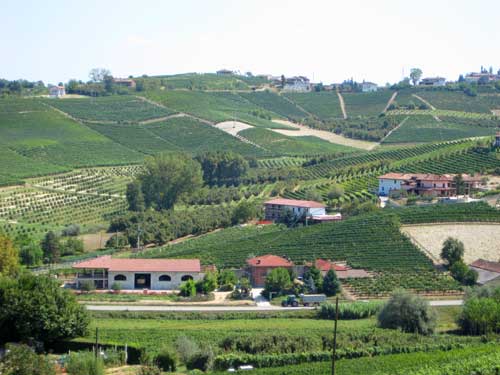
Barbaresco and Barolo, But Don’t Forget Dolcetto, Barbera and the Whites
— — — — —
New: See Rascal’s Travels: Hail Cesare in Piemonte at: http://rascalspalate.com/?p=21
— — — — —
I could not remember my previous experience with wine made from Nebbiolo, but study and reading prepared my expectations of its dark, tannic qualities. Our drive along the Tanaro River northeast from Alba was directed at the commune of Barbaresco as a starting point. From there, we started our experience with the Nebbiolo-based wine that takes its name from the commune. The wines of Barbaresco are perhaps the most approachable Nebbiolo in the region due to their lighter qualities than found in Barolo to the southwest.
Producttori del Barbaresco
It was apparent that the previous day’s nebbia left on cat’s feet (as Sandburg would say) during the darkness of night yielding the yellow warmth of the morning sunrise at the Hotel Langhe (http://www.hotellanghe.it/home-eng.php) near the center of Alba. The winding road up the Barbaresco hillside offered picturesque vineyards holding ripening grape clusters soon to submit fruity, sweet liquid at the Producttori del Barbaresco (www.produttoridelbarbaresco.com). As we arrived, we were greeted by Aldo and Lucca at this regional cooperative winery that is well regarded for its quality production of local wines from a selection of about 50 small vineyards. We walked to the base of the village tower to scan the Langhe hills and the green-blue water of the Tanaro River. This was a good vantage point for a short eno-geology lesson. We returned to the winery for samplings of the 2007 Langhe Nebbiolo (DOC) highlighting grapes from regional young vines followed by the 2005 and 2004 Barbaresco (DOCG).
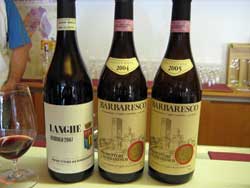 The 2007 Langhe Nebbiolo was very approachable from just six months in botti (large neutral oak casks) and six months in bottle. It provided a simple delicacy of sour cherry carried by moderate tannin and crisp acidity; obviously an entry level Nebbiolo. It was equally evident with the tasting of the two following wines that their characteristics were made for aging with the potential for at least 10 years. These qualities were obtained from long maceration followed by nearly two years aging in oak. The 2005 exhibited moderate grape intensity whereas the 2004 presented riper fruit from that year’s hotter summer temperatures. The characteristics of these wines drew comparisons to the tannic structure of strong green tea carried by light floral aromatics and red fruit flavors that should develop with further bottle age.
The 2007 Langhe Nebbiolo was very approachable from just six months in botti (large neutral oak casks) and six months in bottle. It provided a simple delicacy of sour cherry carried by moderate tannin and crisp acidity; obviously an entry level Nebbiolo. It was equally evident with the tasting of the two following wines that their characteristics were made for aging with the potential for at least 10 years. These qualities were obtained from long maceration followed by nearly two years aging in oak. The 2005 exhibited moderate grape intensity whereas the 2004 presented riper fruit from that year’s hotter summer temperatures. The characteristics of these wines drew comparisons to the tannic structure of strong green tea carried by light floral aromatics and red fruit flavors that should develop with further bottle age.
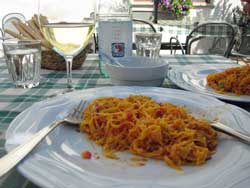 Following the morning tasting at the Barbaresco cooperative, we took a light meal at Antica Torre in the shadow of the ancient brick tower aside the restaurant from which the restaurant takes its name. It was recommended by Alfonso Cevola, The Italian Wine Guy (www.alfonsocevola.com) as the “real deal” and not just another tourista stop. The simple lunch included superb handmade egg pasta and tomato and a surprisingly refreshing white wine locally produced from Sauvignon Blanc and Arneis grapes grown in Roero just to the north.
Following the morning tasting at the Barbaresco cooperative, we took a light meal at Antica Torre in the shadow of the ancient brick tower aside the restaurant from which the restaurant takes its name. It was recommended by Alfonso Cevola, The Italian Wine Guy (www.alfonsocevola.com) as the “real deal” and not just another tourista stop. The simple lunch included superb handmade egg pasta and tomato and a surprisingly refreshing white wine locally produced from Sauvignon Blanc and Arneis grapes grown in Roero just to the north.
The Paulo Scavino Estate
One of the most surprising aspects of the Nebbiolo regions of Barbaresco and Barolo is their compact layout. From Barbaresco on the east flank to Barolo on the west is only a drive of 45 to 50 minutes. If I could have driven the posted speed limit on the winding roads, the drive time could have been even shorter, and also qualified me for the Italian Formula One team, if possible.
We worked our way down to the commune of Castiglioni Falletto just east of Barolo during the warming early afternoon. Our next stop was at the Paolo Scavino estate (www.paoloscavino.com) where we were greeted by Eliza Scavino, granddaughter of the founder Paulo. We were guided through the winery (www.paoloscavino.com) by Weston Hoard, a young American sommelier that left his native Minnesota to seek out a deeper education in wine, looking for something in Barolo not possible in many other wine regions. In Barolo, the experience is about the zenith of a single wine grape (Nebbiolo) and the surrounding elements of Piemonte terroir. The added benefit being in the Scavino winery was learning from winemakers recognized for innovations and leadership in the still evolving modern Barolo style.
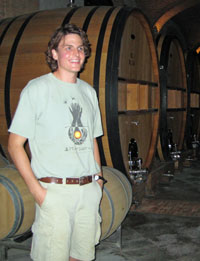 We toured the winery during early harvest; watching white grapes of Arneis, Sauvignon Blanc and Chardonnay as they entered. The fruit was high quality, clean and crisp. The modern stainless steel fermentation vats with rotary paddles and automated punch down screens were still waiting the Nebbiolo grapes for which they were especially designed. The important aspect of these innovations was to reduce the traditionally long maceration and fermentation times and to better extract color and flavor, thus bringing out more fruit qualities in the wine yielding better balance to Nebbiolo’s natural tannic and acidic qualities.
We toured the winery during early harvest; watching white grapes of Arneis, Sauvignon Blanc and Chardonnay as they entered. The fruit was high quality, clean and crisp. The modern stainless steel fermentation vats with rotary paddles and automated punch down screens were still waiting the Nebbiolo grapes for which they were especially designed. The important aspect of these innovations was to reduce the traditionally long maceration and fermentation times and to better extract color and flavor, thus bringing out more fruit qualities in the wine yielding better balance to Nebbiolo’s natural tannic and acidic qualities.
The tasting proved very fascinating as it highlighted not just the Nebbiolo-based Barolo wines, but also included some of the new facets of local winemaking and insights into the qualities of aged Barolo. The Scavino wines tasted are highlighted below:
2008 Langhe Bianco
An appealing blend of 25 percent Viognier and Chardonnay, and 75 percent Sauvignon Blanc from the surrounding Langhe hillsides. This was perhaps the most unexpected wine as it characterized fresh citrus and floral qualities derived from minimum skin contact and cold fermentation with crisp acidity and a lingering minerality.
2008 Dolcetto d’Alba
This friendly fruit driven wine was made without oak aging gaining structure from its natural tannic qualities. This could be a white wine drinker’s red wine. In the region, this type of wine is commonly referred to as “breakfast wine” as it is popular with the local growers to drink with a morning meal after working 3 or 4 early hours in the vineyards.
I was very interested in this wine as we are starting to see what could be called “Dolcetto d’Texas” and it is catching some attention. An example is the 2007 Mandola Dolcetto. The grapes in this wine are the handiwork of Texas grower Cliff Bingham (www.binghamfamilyvineyards.com) who also touts this varietal as good for Texas as he claims, “This variety of grape almost grows itself on the Texas High Plains”.
2008 Barbera d’Alba
The Barbera had a similar fruit-forward style to the Dolcetto, but with a bright zip of acidity. This is an everyday wine that has all of the essentials for pairing with a wide range of food and preparations – dark cherry fruit, low tannin and a bright snappy finish; an important trait of food friendly wines.
After our fun and banter with the first three wines, Weston turned a bit more serious when presenting the 2005 Scavino Barolo. The comparison that he made was to the similarities between the wines and terroir of Burgundy and that in Barolo. He said, “It is all wrapped up in the qualities of a single grape variety. In Barolo, it’s Nebbiolo and in Burgundy, it’s Pinot Noir. Furthermore, Burgundy is characterized by many small producers and a terroir that can vary greatly over surprisingly short distances and the same goes in Barolo. But, the biggest difference between these regions is that Barolo has only developed in the past 30 or 40 years, whereas Burgundy has been at it for a millennium or more. There is still much to learn here.”
2005 Barolo
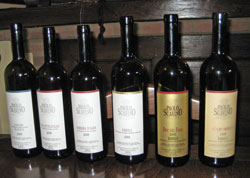 While young, this wine carried all of the attributes normally ascribed to the wines of Barolo. The first impression of the wine was from my visual and aromatic evaluation. The wine was dark, almost black in color but the aroma is incredibly light, but having a wide spectrum of elements with low tones of tar and high floral notes on the top. The following taste melded dark earthy flavors with a bright note of sour cherry. The wine spent 1 year in neutral oak botti, 1 year in French barrique and one year in bottle, but has the potential for a decade or more of further bottle aging.
While young, this wine carried all of the attributes normally ascribed to the wines of Barolo. The first impression of the wine was from my visual and aromatic evaluation. The wine was dark, almost black in color but the aroma is incredibly light, but having a wide spectrum of elements with low tones of tar and high floral notes on the top. The following taste melded dark earthy flavors with a bright note of sour cherry. The wine spent 1 year in neutral oak botti, 1 year in French barrique and one year in bottle, but has the potential for a decade or more of further bottle aging.
2005 Bric del Fiasc (Single Vineyard Barolo)
The modern history of the Scavino family started with this vineyard, within the Fiasco cru, when in 1978 young Enrico Scavino convinced his father Paolo to vinify these grapes separately. This vineyard has been produced as a monopole since that time. Here the Nebbiolo grapes always seem to be the best. This wine provided a useful comparison between the previous Barolo from Nebbiolo blended with a number of local vineyard sites and this single vineyard wine. The reference to Bric (or Bricco) in the name was noted as it is a term reserved for south-facing hillside vineyards that gain late season ripening from this exposure. This wine was immediately appealing due to its intense dark color and wide spectrum of aromas as was the case with the previous wine. But, the Bric del Fiasc presented a special quality of supple tannins and soft texture that combined rich fruit and toasty nuances – best to summarize as power with elegance.
1999 Barolo Carobric
This Barolo is made as a blend of three important crus: Rocche di Castiglione, Fiasco in Castiglione Falletto and the ethereal Cannubi of Barolo. This tasting highlighted the influence of age on the Barolo experience. 1999 was a powerful vintage from an unprecedented string of excellent Barolo vintages that ran from 1995 through 2001. As with the younger Barolo, this wine was still inky black; it did not give visual indication of its age. However, the Carobric was distinguishable from its remarkably sweet floral aroma that was hard to describe as it was nothing that I had yet experienced. This aged wine also yielded a special range of characteristics including anise, chocolate and minerality on the finish.
In the next installment, we will go down the road a bit to Serralunga d’Alba for a tour at Fontanfredda and dinner with Chef Cesare at the estate’s Villa Contessa Rosa.

I love this post! I would really like to make a similar trip. I have really fallen in love with Italian wine here recently. The really exciting thing is that some of these Italian grapes have been showing a lot of potential here in the Texas High Plains.
You are spot on with your comment. Right now, Texas growers are providing some very good grapes from still young vines that results in excellent Italian and TexMed style wines.
Examples include, red wines like Sangiovese, Dolcetto,and even Aglianico and whites include Vermentino, Trebbiano and most surprising to me is Pinot Grigio. Most of these are coming from the Texas High Plains AVA. More information on this region is given online at:
http://txwineregions.tamu.edu/highplains_tech.htm